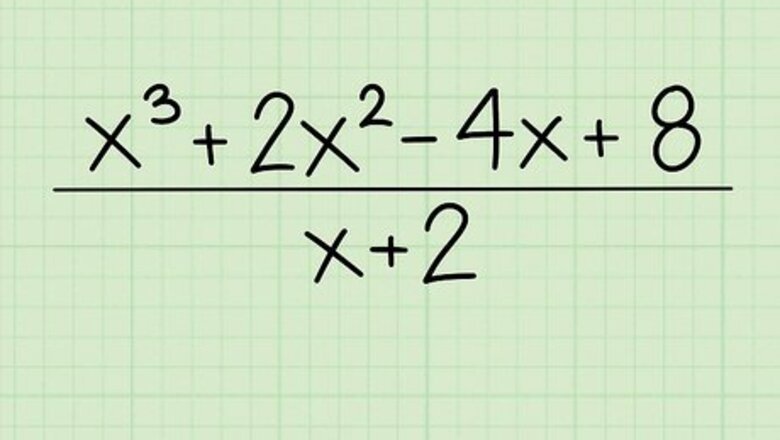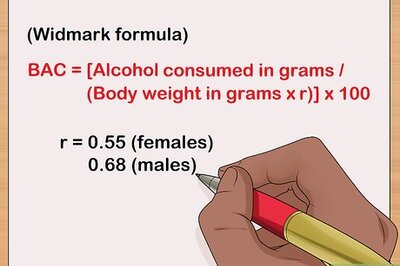
views
X
Research source
If you want to know how to divide polynomials using synthetic division, just follow these steps.
- Reverse the sign of the constant in the divisor and write it in a box. Then, write the coefficients in the dividend in a line next to it.
- Bring down the first coefficient, multiply it by the number in the box, and write the result under the second coefficient. Then, add the result and the second coefficient.
- Repeat the steps for the remaining coefficients. Remove 1 power from the dividend variables, write them next to the new coefficients, and add the remainder.

Write down the problem. For this example, you will be dividing x + 2x - 4x + 8 by x + 2. Write the first polynomial equation, the dividend, in the numerator and write the second equation, the divisor, in the denominator.

Reverse the sign of the constant in the divisor. The constant in the divisor, x + 2, is positive 2, so reversing the sign of the constant would give you -2.

Put the opposite of the constant term in a box. If the opposite of the constant term is -2, we put the -2 inside a box. A common mistake is to put a 2 inside the box, watch out here.

Write all of the coefficients of the dividend inside the division symbol. Write the terms from left to right, just as they appear. It should look like this: -2| 1 2 -4 8.

Bring down the first coefficient. Bring down the first coefficient, 1, below itself. It should look like this: -2| 1 2 -4 8 ↓ 1

Multiply the first coefficient by the divisor and place it under the second coefficient. Simply multiply 1 by -2 to get -2 and write this product under the second term, 2. Here's how it would look: -2| 1 2 -4 8 -2 1

Add the second coefficient and the product and write the answer below the product. Now take the second coefficient, 2, and add it to -2. The result is 0. Write this result below the two numbers, just as you would in long division. Here's how it would look: -2| 1 2 -4 8 -2 1 0

Multiply this sum by the divisor and place the result under the third coefficient. Now take the sum, 0, and multiply it by the divisor, -2. The result is 0. Place this number below 4, the third coefficient. It should look like this: -2| 1 2 -4 8 -2 0 1

Add the product and the third coefficient and write the result under the product. Add 0 and -4 to get -4 and write this answer below the 0. Here's how it would look: -2| 1 2 -4 8 -2 0 1 0 -4

Multiply this number by the divisor, write it under the last coefficient, and add it to the coefficient. Now, multiply -4 by -2 to get 8, write this answer under the fourth coefficient, 8, and add this answer to the fourth coefficient. 8 + 8 = 16, so this is your remainder. Write this number below the product. Here's how it would look: -2| 1 2 -4 8 -2 0 8 1 0 -4 |16

Place each of the new coefficients next to a variable of one less power than their original corresponding variables. In this case, the first sum, 1, is placed next to an x to the second power (one less than three). The second sum, 0, is placed next to an x, but the result is zero, so you can remove this term. And the third coefficient, -4, becomes a constant, a number without a variable, since the original variable was x. You can write an R next to the 16, because that is the remainder. Here's how it would look: -2| 1 2 -4 8 -2 0 8 1 0 -4 |16 x + 0x - 4 R 16x - 4 R16

Write the final answer. The final answer is the new polynomial, x - 4, plus the remainder, 16, over the original divisor, x + 2. Here's how it would look: x - 4 +16/(x +2).




















Comments
0 comment